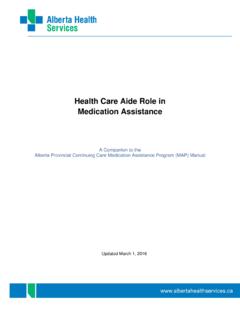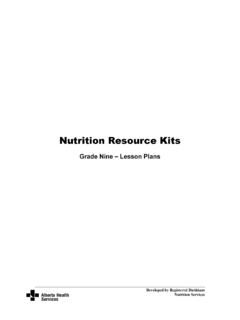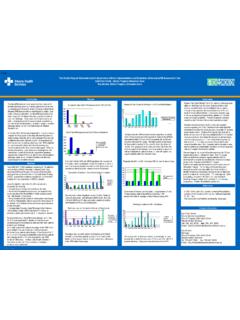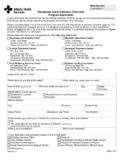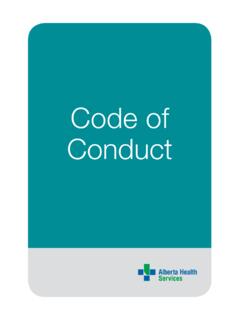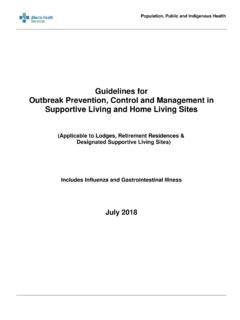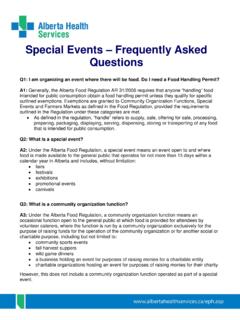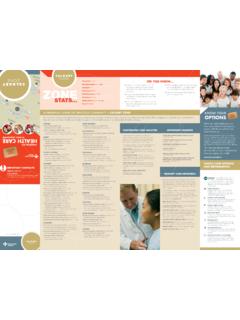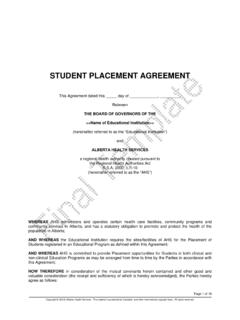Transcription of Copyright © 20
1 Copyright 2020. Alberta Health Services. This material is protected by Canadian and other international Copyright laws. All r ights reserved. These materials are intended for general information only and are provided on an "as is", "where is" basis. Although reasonable efforts were made to confirm the accuracy of t he information, Alberta Health Services does not make any representation or warranty, express, implied or statutory, as to the accuracy, reliability, completeness, applicability or fitness for a particular purpose of such information. These materials are not a substitute for the advice of a qualified health professional. Alberta Health Services expressly disclaims all l iability for the use of t hese materials, and for any claims, actions, demands or suits aris ing from such use. Licensed under the Creative Commons Attribution-Non-Commercial-No Derivatives International License.
2 Contact Instructions on How to Use the Teacher s Guide This guide contains everything you need to offer interactive nutrition education to your junior high and high school students, including printable station titles, instructions, worksheets and activity materials. Each station can be completed as a stand-alone activity. They do not have to be completed in the same order as in the guide. An overview of the stations is located in Table 1. References available upon request. Each station contains: Activity Description Key Messages Station Materials Includes hand-outs and other materials needed for the students to complete theactivity The Canada Food Guide Snapshot can be ordered here. It can take several weeksfor the resource to It is recommended to review the hand-outs and activity materials in advance offacilitating the Key for the Activity Discussion Questions and Answers Supplementary Information and Resources Provides optional additional background information for the teacher to extendlearning on the on How to Use the Activity Stations in your Classroom stations: Provide an overview of each station at the start of the stations on the classroom walls for students to complete at their own pace over irected projects: Provide an overview of each station allowing individualstudents (or groups of students) to choose a station for their self-directed project.
3 Studentscan present their findings back to the 1 station per class: ~45 minutes per activity and discussion. Follow 3 the key nutrition messages and outcomes of the students complete the station worksheet (individually or in groups). over worksheet answers (if applicable). The follow-up discussion questions canbe used in class discussion, small group or individual 1. Overview of the Activity Stations Station Title Materials needed Nutrition Messages and Outcomes Food Detective Student Pre-work: Ask students to search for awebsite or ad that provides nutrition, diet , or foodadvice. Examples: weight loss supplements, foodproducts, or fad diet programs. Canada s Food Guide Snapshot (1 copy) Station Title (print x 1) Station Instructions (print x 1) Answer Key Worksheet: Food Detective worksheet (print x 1 perstudent) Handout: How to find food and nutrition informationyou can trust (print x 1 per student)Choose and Prepare Healthy Food Students will assess the credibility of the nutrition information in the media.
4 Students will learn where to find reliable nutrition information on-line and learn to recognize fad diet information. Cereal Slayer Station Title (print x 1) Station Instructions (print x 1) Answer Key Worksheet: Cereal Slayer (print x 1 per student) Handout: Choose Whole Grains (Nutrition Bitesversion) (print x 5) Handout: Label Reading The Healthy Way (print x 5) Cereals labels print and laminate (Appendix)Choose Whole Grains Students will learn to recognize sources of whole grains and how to determine sugar and fibre content from a Nutrition Facts table. Students will assess added sugar and fibre content of breakfast cereals. Thirst Quencher Student Pre-work: (Optional) Students may bringin their own drink labels or the teacher may use thedrink labels provided. Station Title (print x 1) Station Instructions (print x 1) Answer Key Worksheet: Thirst Quencher (print x 1 per student) Handout: Healthy Drinks, Healthy Kids Drink Labels print and laminate (Appendix)Choose Healthy Drinks Students will review labels and become aware of the added sugar content in some popular drinks.
5 Ingredient Investigation Student Pre-work: (Optional) Students may bringin their own food labels or the teacher may use thefood labels provided. Station Title (print x 1) Station Instructions (print x 1) Answer Key print in colour and laminate (salt is inblue, sugar is in red) display upside down Ingredient Investigation Fact Sheet (print x 1) Worksheet: Ingredient Investigation (print x 1 perstudent) Ingredient lists print and laminate (Appendix) Dry erase markers red and blue, rag (for wiping offlabels)Choose and Prepare Healthy Foods Students will review the ingredient lists on common packaged foods while learning about the various forms of sugar and salt found in foods. Table 1. Overview of the Activity Stations Station Title Materials needed Nutrition Messages and Outcomes Fat Match Station Title (print x 1) Station Instructions (print x 1) Answer Key (display upside down) The Low Down on Fats Fact Sheet (print x 1) Fat Match Cards print and cut each card,laminate or glue to index cards (display rightside up)The Lowdown on Fats Students will learn the types of fats found in common foods and the effect they have on the body.
6 Sodium Analyzer Station Title (print x 1) Station Instructions (print x 1) Answer Key Worksheet: Sodium Analyzer(print x 1 per student) Display items: 1 box of salt, food packages orprinted labels (Appendix) Measuring spoons, clear plastic cups or re-sealable plastic bag to hold salt, one for eachnutrition label Calculator (optional)Hold the Salt Students will be able to determine the amount of salt in processed foods compared to the recommended daily intake. Time Crunch! What to Eat? Station Title (print x 1) Station Instructions (print x 1) Worksheet: Weekly Snack Planner and List ofFoods (print x 1 per student) Handout: Healthy Snacking (print x 5)Steps to a Healthier You Students will be able to practice their creativity and planning skills while making a weekly snack plan. Crunchy, Juicy, or Sweet? You decide! Station Title (print x 1) Station Instructions (print x 1) Answer Key Worksheet: Blank Healthy Plate Optional Handout: Canada s Food GuideSnapshot (print x 5 or order copies) Handout: Eat More Vegetables and Fruit(print x 5) Photos of foods print and laminate (Appendix) Optional: If doing the food sampling thefollowing foods are suggested: spinach, beets,zucchini, sweet potato, jicama, cassava,parsnip, and turnip.
7 Note that none of thesefoods are major allergens. Hand wipes or hand sanitizer Spoons, forks, or toothpicks for tastingEat More Vegetables and Fruits Students will understand the importance of eating a variety of vegetables and fruit, while developing a snack or meal and meal plan that incorporates vegetables and fruits. Activity Station : Food Detective Activity Description Students will: Understand how to assess the credibility of the nutrition information in the media. Learn where to find reliable nutrition Messages Include a variety of healthy foods from Canada's Food Guide to help you get all thenutrients needed to maintain a healthy body. fad diets and many nutrition supplements can be harmful to growing bodies. Manyof these have no evidence that they work. Not all nutrition information in the media is accurate. Be consumer savvy!Materials Student Pre-work: Before completing the station, ask students to search for awebsite or ad that provides some nutrition, diet , or food advice.
8 Examples mightinclude weight loss supplements, food or nutrition supplements, or fad diets . Food Guide Snapshot (order here) Station Title (print x 1) Station Instructions (print x 1) Worksheet: Food Detective Worksheet (print x 1 per student) Handout: How to find food and nutrition information you can trust (print x 1 perstudent)Set-Up Ensure students have been given the opportunity to complete the pre-work (seeabove). Alternatively the teacher can provide examples of ads or websites includingweight loss supplements, food or nutrition supplements, or fad diets . Place station title, instructions, worksheets, and handouts at station. Students can work individually or in small groups to answer the questions on theworksheet Key for the Activity Refer to the student worksheet. The answers to this activity will depend on the examples that students provide. Students are encouraged to use critical thinking skills to create discussion around this topic.
9 Discussion Questions and Answers is a fad diet ?A fad diet is a popular diet that usually promises weight loss. A fad diet often sounds too good to be true and does not follow healthy eating guidelines that support good health. A fad diet often has some of the following characteristics: Promises weight loss of more than 2 pounds (1 kg) per week. Restricts you to less than 800 calories a day. Is strict and does not fit into your lifestyle. Cuts out major food categories (like gluten or carbohydrates) and stops you fromenjoying your favourite foods. Is not sustainable. Requires that you buy the company s foods or supplements rather than showing youhow to make better choices from food bought at a grocery store. Uses counsellors who are actually salespeople. Weight management counsellorsshould not make a commission from anything you buy. Gives you nutrition advice that is based on testimonials rather than scientificevidence.
10 Promotes unproven ways to lose weight such as starch blockers, fat burners, andcolonic cleanses. Does not encourage physical from: are some reasons you would want to avoid fad diets ?Possible answers may include: Ages 12 18 years is a time of rapid growth when your body requires many nutrientsto help you grow and be healthy. When you don t eat well, your body does not getthe nutrients and energy it needs to grow. While youth are growing, weight loss is not recommended. Using an unhealthyapproach to weight loss can be harmful to mental and physical health. Before tryingto lose weight, youth should speak to their parents or health professional. A nutritionally balanced diet follows Canada's Food Guide. fad diets may restrict orexclude certain foods. fad diets may promote unhealthy habits such as: skipping meals, fasting, cleansing,or weight loss that is too fast to be considered healthy.
